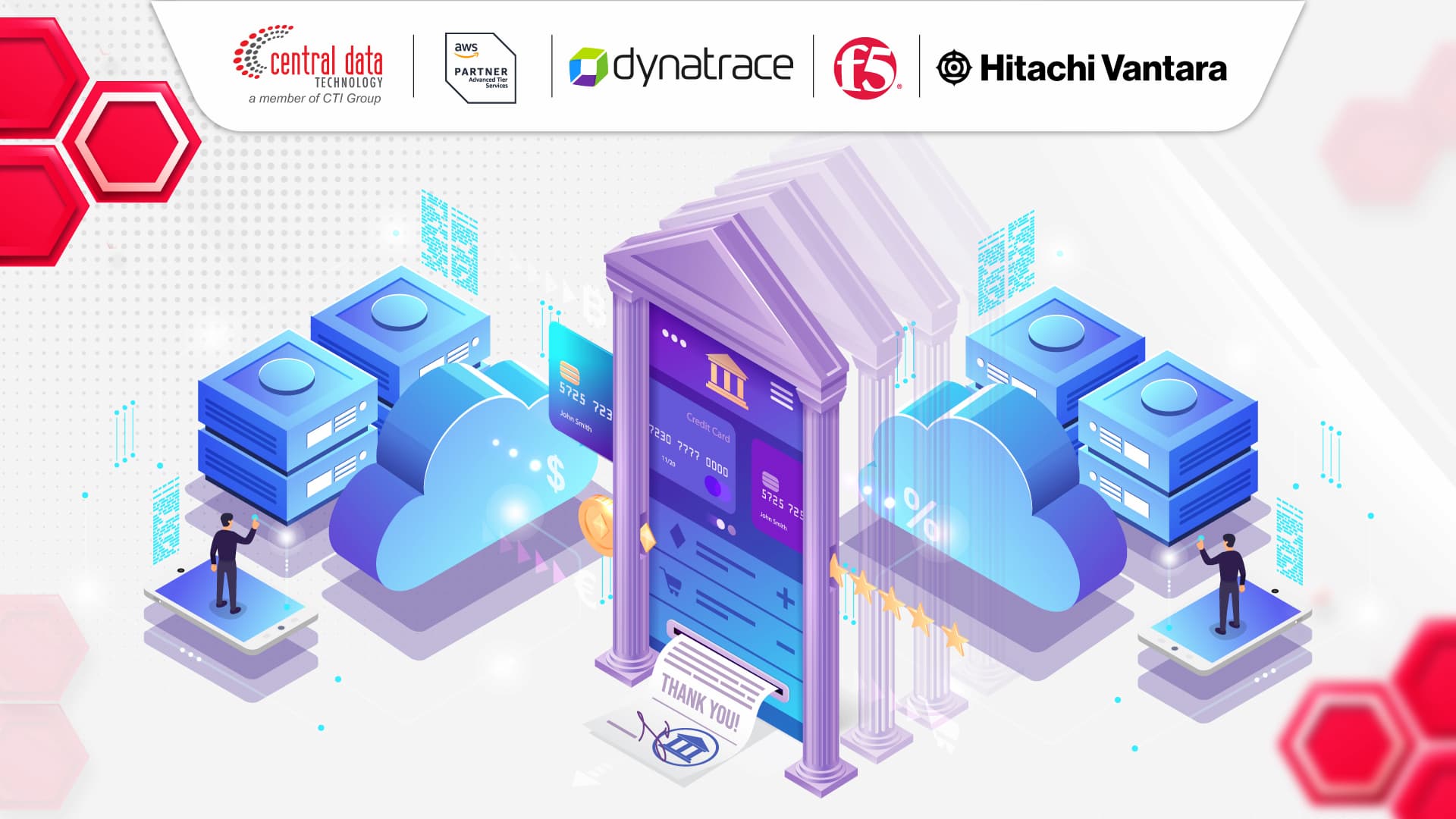
Did you know? Behind the convenience of mobile banking and seamless 24/7 transactions, sophisticated technology operates tirelessly. One of the key foundations of this progress is cloud banking, a modern approach that allows banks to operate more agilely, efficiently, and securely in the digital era.
Cloud banking speeds up services and enables banks to respond more swiftly and adaptively to market changes.
But how exactly does cloud banking work? What are its benefits? And what technology solutions can support its optimal and secure implementation?
What is Cloud Banking?
Cloud banking is a modern approach in the banking world that leverages cloud computing technology to manage data, transactions, and financial services more flexibly and efficiently.
Rather than relying on traditional physical infrastructure, banks can now use cloud platforms to streamline operations and reduce costs.
As a result, banks can launch new products more quickly, process applications in real-time, and handle transaction surges, such as during holiday seasons, simply by adjusting cloud capacity. Flexible, cost-effective, and innovation friendly.
Why is Cloud Banking a Game-Changer in the Banking Industry?
In the digital age, customer expectations are rising. They demand financial services that are instant, secure, and accessible anytime, anywhere. Cloud banking answers these needs.
By harnessing cloud technology, banks can:
- Develop mobile and digital services faster.
- Provide stable and reliable payment systems.
- Enhance service personalization based on customer data analysis.
Beyond service enhancements, cloud banking also drives cost efficiency. Without the need for heavy investments in physical infrastructure, banks can allocate more of their budget to innovation and product development, directly impacting the customer experience.
5 Real Benefits of Cloud Banking for the Banking Industry
Here are the top five reasons why cloud banking is the go-to choice in the banking sector:
1. Reduced Operational Costs
Without the need to manage physical infrastructure, banks can significantly cut maintenance and long-term operational costs. With cloud banking, banks only pay for the capacity they use, reducing unnecessary expenses.
2. Flexible and Scalable
Cloud banking allows banks to instantly adjust service capacity according to their needs, especially during transaction surges, like during holiday seasons or major promotional campaigns, without system disruptions.
3. Access to Cutting-Edge Technology
Cloud opens access to Big Data analytics, AI, and Machine Learning, which help banks analyze customer behavior in greater depth, improve service personalization, and respond to customer needs more precisely.
4. Enhanced Data Protection
Cloud providers offer high-level security systems to protect customer data from evolving cyber threats. This includes encryption, firewalls, and advanced threat detection systems to keep data safe.
5. Faster Innovation
The cloud enables banks to develop and launch new features more quickly. With a flexible infrastructure, banks can introduce innovative services faster than their competitors, maintaining a competitive edge in a dynamic market.
How Does Cloud Banking Work?

Cloud banking shifts banking infrastructure and applications to a cloud-based platform. This allows services like data storage, transaction processing, and digital services to be securely accessed from anywhere.
Banks can choose the cloud model that best suits their needs, whether it’s public, private, or hybrid cloud, based on scalability and security requirements. Every piece of data and application on the cloud is protected with encryption and strict security protocols, ensuring flexibility without compromising data protection.
Risks and Challenges to Consider
Despite offering numerous benefits, implementing cloud banking still requires careful attention. Risks such as loss of control over data, cyberattacks, and difficulty meeting global regulations are some of the challenges banks faces.
To mitigate these risks, banks must ensure:
- Compliance with local regulations, such as Indonesia’s PDP Law or Europe’s GDPR.
- Consistent security policies across all cloud models.
- Comprehensive visibility into the data and systems being used.
As a solution, banks can form close partnerships with trusted cloud providers who can ensure that strict governance and access control are maintained.
Read More: Digital Transformation in Banking: A Solution for The Future of Financial Services
Recommended Cloud Banking Solutions for Banks Ready to Transform
In the face of cloud banking complexities, banks must choose the right technological solutions to remain competitive, secure, and compliant with regulations. CDT recommends several strategic solutions to help financial institutions build a modern, reliable cloud banking system.
AWS: A Reliable and Flexible Cloud Foundation
AWS Elastic Compute Cloud (EC2) is a go-to for many financial institutions in building a robust cloud banking infrastructure. EC2 allows banks to run banking applications on scalable virtual servers, automatically adjusting based on demand.
With AWS, banks can accelerate digital service launches, cut operational costs, and maintain system availability during spikes in demand, such as on holidays or during promotional periods.
Beyond scalability, AWS excels in ease of management. Users can easily configure instances, security settings, and integrate with other services like Amazon S3 for storage and RDS for database management. Features like comprehensive encryption, IAM, and support for private and hybrid clouds ensure AWS remains compliant with financial industry regulations.
Learn More: AWS Cloud Services
Dynatrace: Smart Observability for Optimal Customer Experience
Digital transformation in banking is inseparable from intelligent system monitoring. Dynatrace is an AI-powered observability solution that provides comprehensive monitoring across infrastructure, applications, and end-user experience.
For banks that have adopted cloud-native solutions, Dynatrace helps identify potential disruptions or bottlenecks before they impact customers banking experience. Thanks to advanced AI analytics, Dynatrace processes millions of metrics in real time and delivers automated root cause analysis, speeding up IT teams’ response times.
More than just monitoring, Dynatrace also supports a DevSecOps approach, ensures regulatory compliance, and strengthens the overall resilience of a bank’s digital systems.
Learn More: Dynatrace
F5: Integrated and Adaptive Application Security
Application security is a top priority in cloud banking. F5 BIG-IP provides an integrated platform that combines Application Delivery Controllers (ADC) with advanced security features.
F5 offers capabilities like load balancing, Web Application Firewall (WAF), DDoS protection, and identity-based access. All of these are designed to maintain the performance and security of services such as internet banking, mobile apps, and APIs.
F5’s technology also supports zero trust architectures and multi-level authentication, making it ideal for hybrid and multi-cloud environments. Additionally, the F5 glossary helps IT teams understand and implement solutions more accurately.
Learn More: F5
Hitachi Vantara: Infrastructure Modernization and AI-Driven Data Utilization
For banks looking to undergo a complete digital transformation, Hitachi Vantara offers a strategic approach to modernizing data centers and utilizing data more effectively.
Hitachi’s solutions include hybrid cloud infrastructure management, secure and efficient data management, and IT service automation. With this approach, banks can seamlessly integrate cloud and on-premises systems without sacrificing reliability or security.
Another advantage of Hitachi lies in utilizing AI and predictive analytics to support business decision-making. This allows banks to improve operational efficiency while creating a more personalized and responsive customer experience.
Learn More: Hitachi Vantara
Time to Move Towards a Stronger Cloud Banking Future with CDT
Digital transformation in the banking sector is no longer just an option; it’s a strategic necessity. With the right cloud foundation, banks can deliver faster, safer services that meet customer expectations in the digital age.
Central Data Technology (CDT), a subsidiary of CTI Group, offers integrated cloud banking solutions from AWS, Dynatrace, F5, and Hitachi Vantara. With deep experience in the financial industry, CDT is ready to help your bank in the selection, implementation, and optimization of cloud solutions tailored to your business needs.
Interested in learning how these solutions can be applied to your bank? Click the link to connect with the CDT team and start your digital transformation with a strong, trusted foundation.
Author: Wilsa Azmalia Putri – Content Writer CTI Group

